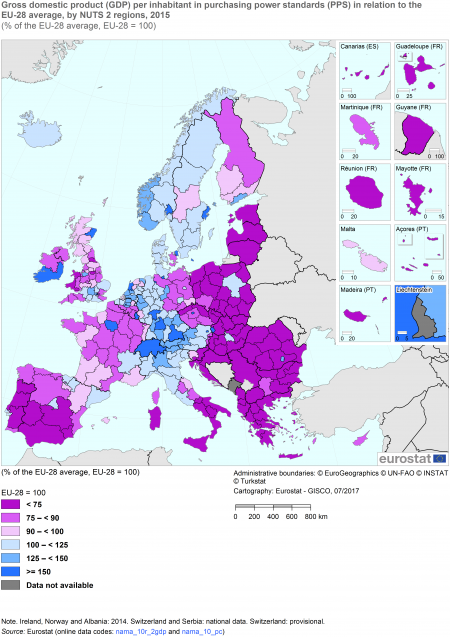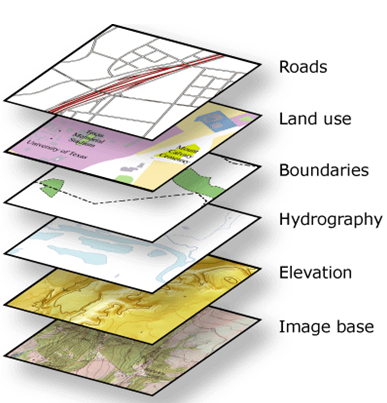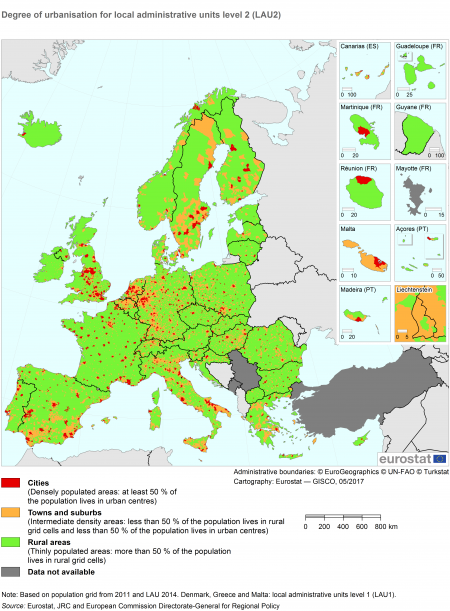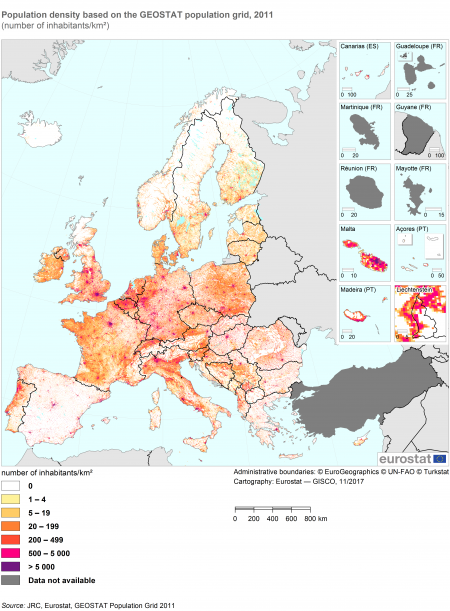Geographical information system of the Commission (GISCO)
This article presents GISCO, the 'Geographical information system of the Commission', a permanent service of Eurostat that answers the needs of Eurostat and the European Commission for geographical information at the level of the European Union (EU), its Member States and regions. The GISCO database contains core geographical data for all of Europe such as administrative boundaries (see Map 2), but also thematic geospatial information, for instance population grid data (see Map 4).
Full article
What is GISCO?
GISCO's main task is to provide reference geographical information and related services for use within Eurostat and the Commission and to the European citizens at large. It also coordinates Commission-wide geographical information activities and common strategies and has the goal to promote and stimulate the use of geographical information within the European Statistical System and the Commission.
GISCO activities consist of the following pillars:
- management of the geographical reference database of the Commission;
- operation of the spatial data infrastructure of the European Commission;
- data processing, mainly for thematic mapping, spatial analysis, and data dissemination;
- coordination and relationships with users and producers (Commission, European agencies, statistical offices);
- promoting activities to integrate geographical information with thematic information, notably statistical information;
- cooperation in initiatives for the establishment of a geographical information infrastructure at the European level (INSPIRE).

Source: Eurostat (nama_r_e2gdp)
Which data can you find in the GISCO database?
The GISCO database contains geographical reference data, mainly for use within the Commission. However, selected datasets are also available to the public:
- Administrative boundaries and statistical units;
- Ports and airports;
- Digital Elevation Model;
- Population distribution;
- Land Cover/Land Use information.
These data can be downloaded from the Eurostat website (http://ec.europa.eu/eurostat/web/gisco/geodata).
What is GIS and how can it be applied?
A geographical information system (GIS) is an information system designed to capture, store, manipulate, analyse, manage, and present all types of geo-referenced data. Geo-referenced means that data are associated to their geographical location. This is of course the case for topographic information (roads, rivers, administrative boundaries, …) which can be easily represented on maps. Statistical data collected and disseminated by Eurostat can also be geo-referenced: in fact, statistics are always associated to at least a country and sometimes further down to a region, a smaller administrative unit, or even to a point.
The geo-referencing of statistical data has first been used to create statistical maps for Eurostat publications and, more recently, for electronic products and websites. However, the association of geographical information and statistics can generate information far beyond the simple representation of statistics on maps.
Data that are geo-referenced can be combined with numerical data for spatial analysis in order to produce information that allow relationships and patterns to be visually recognised, making evident phenomena which would be harder to be discovered just through statistical tables. Moreover, the combination of computer processing power and GIS allows a multitude of different spatial-statistical analyses to be undertaken.
Geographical information can be used in a variety of applications. One of the most obvious examples is in relation to regional policy allowing regional and local administrations to more closely follow policy initiatives.
Administrations increasingly use spatial data in order to prepare strategic decisions in relation to transport and regional planning. As an example, the analysis of infra-regional statistics can be used to create indicators such as population density, the degree of urbanisation, patterns of travel, or to measure the availability of local infrastructures.
Other areas where geographical information is of particular interest include agriculture and the environment. Both of these areas have benefitted from advances that have been made in terms of satellite imaging and remote sensing techniques. These allow an alternative means of collecting data in addition to in-situ data. The combination of remote sensing techniques and existing geographical information allows for more effective monitoring, as well as easier modelling of the impact of (environmental) changes, at a local, national, international, and even global level.
In the domain of transport and infrastructure, geographical information can provide information on the means of transport at a local or regional level, as well as the availability and accessibility of transport and transport infrastructures.
How does it function?
A GIS must be able to answer several types of questions:
- what can be found at what location?
- what changes have occurred at a specific location?
- what happens if…? (measurement of the impact of modifications of certain parameters at certain locations, modelling, simulation,…).
The analysis of elements which are linked with space in this way necessitates the availability of data on the underlying geographical or topographical situation, such as:
- relief and altitude;
- ground cover;
- road networks;
- local infrastructure;
- administrative boundaries;
- etc…
The management of georeferenced data hence requires the use of specific software tools, able to combine different information layers, evaluate spatial and statistical indicators, such as proximity, distance, density, average, etc.
Spatial analysis
So called ‘spatial analysis’ techniques generate results where the ‘whole is greater than the sum of the parts’, leading to information which would be impossible to derive solely from the contribution of statistics or geographical information separately.
GISCO applies spatial analysis in support of the activities of thematic units in Eurostat and other Directorates General of the Commission.
Spatial data analysis allows answers to questions like:
- what is the population density in areas below sea level?
- where are urbanised / rural areas?
- what is the impact of urbanisation on neighbouring areas?
- how long does it take on average to go to a hospital?
- what is the number of inhabitants in the vicinity of an airport?
- how many inhabitants are affected by a certain air quality?
An important element in spatial analysis is the spatial reference framework for thematic data. At the European level, the NUTS with 3 region levels represents the standard territorial classification for statistical information. As an exammple for the smallest regions at NUTS level 3 (equivalent to French ‘départements’ or German ‘Kreise’) thei size may vary from a minimum of 13 km2 to a maximum of 98 249 km2. It is evident that for phenomena related to the surface of a territory and when distribution can vary a lot (for example, the population density), it is extremely difficult to apply spatial analysis techniques and get reliable results. GISCO is therefore promoting grid statistics as a complementary solution for the analysis of spatial phenomena.
Direct access to
- All background articles on regional typologies
- LUCAS - Land use and land cover survey (background article)
- Population grids (background article)
- Geodata, for downloadable geodata files
- Eurostat regional yearbook (online publication)
- Regulation (EU) No 1253/2013 of 21 October 2013 amending Regulation (EU) No 1089/2010 implementing Directive 2007/2/EC as regards interoperability of spatial data sets and services
- Directive 2007/2/EC of 14 March 2007 establishing an Infrastructure for Spatial Information in the European Community (INSPIRE)
- Statistical Atlas - select statistical domain 'Population' (top right)



